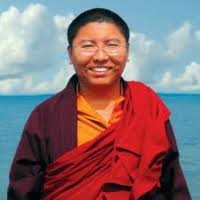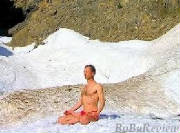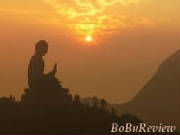|
Tibetan Buddhist nuns at high altitude in a palpable
spiritual atmosphere
 The blessing of “Blessings: The Tsoknyi Nangchen Nuns of Tibet,” a movie about the renunciant Tibetan-Buddhist nuns of Nangchen, is that it takes us to an incredibly exotic location
most of us will never get to on our own and shows us the almost unimaginable lifestyle of groups of women practitioners at
altitudes upwards of 10,000 feet. The blessing of “Blessings: The Tsoknyi Nangchen Nuns of Tibet,” a movie about the renunciant Tibetan-Buddhist nuns of Nangchen, is that it takes us to an incredibly exotic location
most of us will never get to on our own and shows us the almost unimaginable lifestyle of groups of women practitioners at
altitudes upwards of 10,000 feet.
Chariot Production’s new documentary, narrated by Richard Gere,
about life in the rarefied mountain air and equally rarefied spiritual atmosphere of the network of Nangchen nunneries, three
days hard travel from Beijing, will be an eye-opening experience for most Westerners.
 The movie was undertaken at the request of Tsoknyi Rinpoche III, as a way
of documenting the extraordinary lives of the hundreds of yogini-nuns under his spiritual guidance. In what is known
as “the land of meditators,” the nuns of Nangchen are revered throughout the mountainous, remote region for their
remarkable levels of realization. The movie was undertaken at the request of Tsoknyi Rinpoche III, as a way
of documenting the extraordinary lives of the hundreds of yogini-nuns under his spiritual guidance. In what is known
as “the land of meditators,” the nuns of Nangchen are revered throughout the mountainous, remote region for their
remarkable levels of realization. Conditions at the various nunneries are primitive
at best. Yet the nuns ably maintain themselves even as they
adhere to strict meditation schedules; they take turns caring for each other
in three-year retreats in which they pray, study, and practice, sitting upright in a traditional
wooden meditation box. Their dedication and devotion is daunting by any contemplative
standard, particularly contemporary ones. The difference between these yogini-practitioners
and Western nuns is worth mentioning. While the latter are often cloistered,
there is usually an emphasis on doing good works, what would be called “karma yoga” in Buddhism. The Tibetan yoginis of Nangchen, while they are a strong positive
factor in the local community, are primarily involved in practices that lead
to enlightenment. Their presence is said to have reduced
crime, violence, even alcoholism in the surrounding areas, according to Tsoknyi Rinpoche.  The nuns of Nangchen are renowned for their mastery of tummo, or inner heat meditation, but this ritual is not allowed to be filmed because of its highly sacred
aspect. (Tummo makes
it possible for adepts to dry wet sheets on their bodies, outdoors, in the middle
of a Himalayan winter, and is as much a proof of spiritual accomplishment as
a handy way to stave off freezing to death in unheated buildings or caves.) The nuns of Nangchen are renowned for their mastery of tummo, or inner heat meditation, but this ritual is not allowed to be filmed because of its highly sacred
aspect. (Tummo makes
it possible for adepts to dry wet sheets on their bodies, outdoors, in the middle
of a Himalayan winter, and is as much a proof of spiritual accomplishment as
a handy way to stave off freezing to death in unheated buildings or caves.)
Though there is a long tradition of women
practitioners in Tibet, they’ve had,
not surprisingly, much more of a struggle than their male counterparts.
The word for woman in Tibetan means
“lower-birth,” partly because they historically had little or no time
for spiritual practice if they became wives and mothers. Western
women Buddhists Jetsunma Tenzin Palmo and Tsultrim Allione speak movingly in
the film about the determination of these women of Nangchen
to become educated in Buddha-dharma -- and their ability to become awakened.
“Buddha-nature is the same for
all sentient beings.” Happily, patriarchal discrimination against
women is becoming passé in all spheres, including the spiritual. The lineage of Tsoknyi
Rinpoche III goes back to the first Tsoknyi Rinpoche, who instructed his disciple Tsang Yang Gyaltso to build
nunneries in the late 19th century. When
the nunneries were destroyed during the Cultural
Revolution, the nuns dispersed, but some continued practicing.
In recent times, a younger generation of yoginis has re-united at
the far-flung nunneries to renew their vows and practices, often being taught by the
few remaining older nuns who survived. disciple Tsang Yang Gyaltso to build
nunneries in the late 19th century. When
the nunneries were destroyed during the Cultural
Revolution, the nuns dispersed, but some continued practicing.
In recent times, a younger generation of yoginis has re-united at
the far-flung nunneries to renew their vows and practices, often being taught by the
few remaining older nuns who survived.
Their teachings emphasize mind and heart openings. Loving-kindness,
compassion, and bodhichitta, as well as intellectual philosophy, are part of
their daily regimen. Tsoknyi Rinpoche points out that the
real purpose of practice is to relieve the suffering of others. He adds that
even with “a simple life in the U. S., men or women can become enlightened [through] gradual practice.”  This is good news for those of us on the path in the West,
because following in the footsteps of the yogini nuns of Nangchen would probably prove impossible
physically for most of us. Metaphysically, however, is a different matter. This is good news for those of us on the path in the West,
because following in the footsteps of the yogini nuns of Nangchen would probably prove impossible
physically for most of us. Metaphysically, however, is a different matter.
In a brief but memorable meeting at the end of “Blessings,”
Sherab Zangmo, who has been a nun for all of her very long life, rests in her meditation box, spinning her prayer wheel,
and prays for all of us, that we may become happy and free from suffering. The
Nangchen nuns show us the possibility of the transformation of priorities, from
war to peace, hatred to love.
Purchase this
documentary by Chariot Videos 3,000 nuns
and their extraordinary journey practicing Tibetan Buddhism in
remote Eastern Tibet
|
|
|

